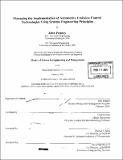| dc.contributor.advisor | Charles Fine. | en_US |
| dc.contributor.author | Penney, John, 1974- | en_US |
| dc.contributor.other | System Design and Management Program. | en_US |
| dc.date.accessioned | 2006-11-08T16:29:23Z | |
| dc.date.available | 2006-11-08T16:29:23Z | |
| dc.date.copyright | 2004 | en_US |
| dc.date.issued | 2004 | en_US |
| dc.identifier.uri | http://hdl.handle.net/1721.1/34737 | |
| dc.description | Thesis (S.M.)--Massachusetts Institute of Technology, System Design & Management Program, 2004. | en_US |
| dc.description | Includes bibliographical references (p. 79-80). | en_US |
| dc.description.abstract | In the 1940s and 1950s poor air quality in major metropolitan areas throughout the United States started to negatively influence the health of citizens throughout the country. After numerous studies the government concluded that mobile sources of air pollution were a significant contributor to the deteriorating air quality. From that point onwards, the automobile manufacturers have been forced to comply with ever tightening emission regulations. This thesis describes an original investigation into the conflicting clockspeeds that prohibit rapid integration of new automobile emission technologies into production automobiles. Common themes and barriers to technology implementation are uncovered by systematically analyzing current production emission technology and exhaust gas after-treatment systems, and investigating how those systems have evolved over the years. A heuristic for analyzing the technology clockspeed is developed by decomposing the problem into four interconnected cycles. These four cycles correspond to the government's process to develop new automobile emission control regulations and the automobile manufacturer's ability to engineer and certify vehicle platforms, engines, and combustion after-treatment systems. This thesis analyzes the emission control technology development process in six chapters. The first chapter deals with setting the scope and defining the boundaries of the systems that will be analyzed. Chapter two analyzes the driving forces behind the creation of emission regulations and the legislative processes that transform ideas into law. Chapter three analyzes the second level decomposition of the problem at the vehicle level with a specific emphasis on Ford Motor Company's Fox vehicle platform. | en_US |
| dc.description.abstract | (cont.) The fourth chapter decomposes the problem to the engine system level with a focus on the production history of American V8 engines. Chapter five investigates the management of a catalytic converter development program and recommends an organizational structure to efficiently develop catalytic converter systems. The organizational structure recommendation is based on results obtained from a task oriented design structure matrix and a system engineering decomposition. | en_US |
| dc.description.statementofresponsibility | by John Penney. | en_US |
| dc.format.extent | 80 p. | en_US |
| dc.format.extent | 4772554 bytes | |
| dc.format.extent | 4781135 bytes | |
| dc.format.mimetype | application/pdf | |
| dc.format.mimetype | application/pdf | |
| dc.language.iso | eng | en_US |
| dc.publisher | Massachusetts Institute of Technology | en_US |
| dc.rights | M.I.T. theses are protected by copyright. They may be viewed from this source for any purpose, but reproduction or distribution in any format is prohibited without written permission. See provided URL for inquiries about permission. | en_US |
| dc.rights.uri | http://dspace.mit.edu/handle/1721.1/7582 | |
| dc.subject | System Design and Management Program. | en_US |
| dc.title | Managing the implementation of automotive emission control technologies using systems engineering principles | en_US |
| dc.type | Thesis | en_US |
| dc.description.degree | S.M. | en_US |
| dc.contributor.department | System Design and Management Program. | en_US |
| dc.identifier.oclc | 55627381 | en_US |
